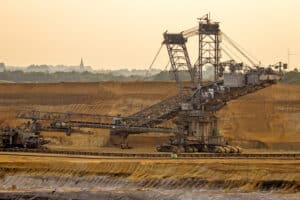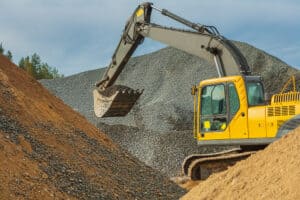You may have heard of mining shovels but still have no clue what they are exactly.
A mining shovel is used in mining operations. It helps in excavating or digging, so a mining shovel can dig into the ground, coal, ore, or other materials.
A mining shovel may also be a gas/diesel-operated multi-purpose machine as this big version helps move large amounts of ground or dug-up material from one place to the other.
Using gas operated mining tools, one can excavate a whopping 168 cubic meters of material in just one scoop.
It is an essential tool for building roads, tunnels, railways, and many different construction sites.
To operate a mining shovel, you need electricity or fuel such as diesel. However, there is not one but many different types of mining shovels that work in different ways.
Table of Contents
Power Mining Shovel
Also known as stripping shovel, electric mining shovel, or front shovel, this is a bucket-equipped mining machine that is generally powered using electricity.
The power shovel uses a rope or cable for excavation and a digging arm, which gets its power from the movement of steel ropes or winches.

Typically, there is a revolving deck and a front attachment like a crane and a dipper with a bucket.
With most modern models, the bucket capacity can range from 8 m3 to nearly 80 m3.
This shovel is perfectly adequate for mining only and is not equipped for handling heavy construction.
Dragline Mining Shovel
The dragline mining shovel is handy when it comes to precise excavations due to the shovel bucket’s flexibility.
It is mainly positioned high up in the mining site, and it has a long-reaching boom to perform downward operations effectively.
As the bucket is set at a high point plus it has a long arm, it also helps move or dump materials from one location to another very quickly.
One factor to remember is that the dragline mining shovel is extremely heavy. So, the machine itself is not portable or easy to move.
Dragline mining shovels are used primarily for surface mining, harbor construction, deep excavation or road excavation, and even underwater tasks.
They generally have a digging depth of at least 65 meters or 213 feet.
Due to their immense size, the system can be pretty inflexible at times.

Bucket Mining Shovel
Contrary to the dragline mining shovel, the bucket mining shovel is a lighter-weight option.
It works by cutting the ground or surface outwards from the point where you set it, and it runs on tracks.
One of the main features of the bucket shovel is the heavy boom, which provides immense support during excavation operations.
Generally, there is the option to opt for the type of bucket required according to the task at hand.
For instance, you can go for a heavy rock bucket, an iron ore bucket, a coal bucket, an extreme duty bucket, or a standard rock bucket.
These different buckets are designed and optimized to extract materials with varying densities.
Bucket mining shovels are widely available and come in a range of sizes and measurements, so they are a great option.

Hydraulic Excavator
The hydraulic excavator is also among the larger vehicle machines.
The unique thing is that a hydraulic excavator is great at demolition as well as excavation.
The main parts of the hydraulic excavator are the bucket, boom, and chassis.
It also has wheels to help it move along tracks.
The hydraulic excavator comes in a range of sizes and can weigh from 3000 pounds to 2 million pounds.
Whatever the size, they all perform similarly to complete the given operation.
The speed of the hydraulic excavator can range from 19HP to 4,500 HP.
Several advantages of using a hydraulic excavator are that you can get smaller ones for more specific tasks; plus, they are easily transported.
You can add different attachments to it to make it more multi-purpose.
For instance, placing a specialized blade on the hydraulic excavator turns it into a scraper, and demolition is easier using a mallet attachment. You can even attach a grapple to pick up objects.

These machines sure beat the the hands on digging of many men.
However there is a downside, it is expensive equipment, and it does drink up lots of fuel.
Even the repairing process is complicated because of how big the hydraulic excavator is.
Though not an investment for personal use, it is a great machine and a good investment for large operations as it will last for many years.






